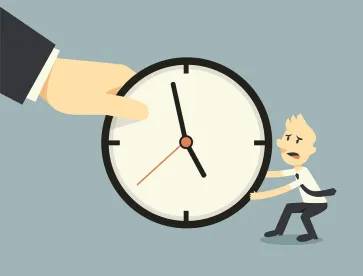Given the number of states that have already ordered the closure of non-essential businesses due to the COVID-19 pandemic, employers fortunate to remain operational are likely dealing with the myriad challenges of a remote workforce.
As we previously wrote here, employers with work-from-home (“WFH”) policies in place need to make sure they are appropriately compensating their workers and are otherwise complying with all applicable federal, state, and local wage and hour laws.
In the WFH context, the related wage and hour concepts of “waiting time” and “on-call time” can be particularly thorny. At a high level, these terms refer to periods of time when non-exempt employees are not engaged in active productive labor, but are scheduled and available to work, or expected to work upon demand. Under the Fair Labor Standards Act (“FLSA”), if an employee’s on-call or waiting time at home are “hours worked,” then the employee must receive compensation for such time.
Waiting Time
With many businesses operating at reduced capacity and/or focused on providing core services, a large number of non-exempt employees working from home may not have eight hours’ worth of work to do during their regularly scheduled hours and may find themselves idle for significant amounts of time as they await direction from management. Are employers required to pay employees for all time when employees are at home waiting for work? Not necessarily.
Under the FLSA, the threshold inquiry is fact driven — is an employee is “engaged to wait,” which is compensable, or “waiting to be engaged” to work, which is non-compensable? See 29 C.F.R. §§ 785.14–16.
Under the implementing regulations, an employee is “engaged to wait” and considered on-duty when “waiting is an integral part of the job,” which may often be during “unpredictable” periods or periods “usually of short duration” in which the employee’s time “belongs to and is controlled by the employer.” 29 C.F.R. § 785.15. “Waiting is an integral part of the job” when, e.g., a truck driver waits for others to load or unload goods from his truck or a bus driver guards the bus before making a scheduled return trip. On the other hand, when an employee is “completely relieved from duty” and can “use the [inactive] time effectively for his own purposes,” he is “waiting to be engaged” (unpaid time). 29 C.F.R. § 785.16(a).
When employees are working from home as opposed to at an office, one might assume that they are completely relieved of duty during down periods and can use inactive time for their own purposes – e.g., watching television, playing video games, reading a book, doing yoga, basket-weaving, or any other personal pursuits. However, that is not necessarily the case.
For example, where a supervisor informs a non-exempt employee that they will receive a draft document to review in the next 15 to 45 minutes and must immediately edit that document, the facts would tend to suggest that the employee is engaged to wait during this time (which is work time).
Further, short breaks of less than 20 minutes is compensable time pursuant to federal regulations (as well as many state wage and hour laws). Similarly, if a manager has a standing policy that his direct reports must read and respond to all emails within five-to-ten minutes, at most, and the manager sends emails at regular intervals, then reports could be considering working when they pursue personal pursuits while waiting for an assignment. See, e.g., U.S. Department of Labor Fact Sheet #22 (July 2008), available at https://www.dol.gov/sites/dolgov/files/WHD/legacy/files/whdfs22.pdf; see also Yu G. Ke v. Saigon Grill, Inc., 595 F.Supp. 2d 240, 255-56 (S.D.N.Y. 2008).
By contrast, if an employer sends employees work infrequently and does not require an immediate response, such employees are likely waiting to be engaged during their inactive time – i.e., not working. Non-exempt employees hired shortly before the COVID-19 crisis, who have yet to fully ramp-up, may fall in this category. In the same vein, non-exempt employees who have flexibility in deciding when to complete their daily and/or weekly tasks and can use the time in between such tasks as they want, with little to no interruptions, are likely “waiting to be engaged” in between tasks, i.e. non-compensable time.
On-Call Time
Non-exempt employees who are on-call – meaning that they must be ready to work during a particular period — such as nurses, doctors, and appliance repair technicians, may need to be compensated for that on-call time.
As with “waiting time,” the particular factual context of each case will be determinative of whether on-call time is compensable. Employers who require employees who are on-call to remain on their premises or so close to their premises that the employee cannot use the time effectively for his or her own purposes are considered working while on-call. See 29 CFR § 285.17. In fact, employees who are on-call at home may also be entitled to compensation.
Pursuant to federal regulations, “[t]ime spent home on call may or may not be compensable depending on whether the restrictions placed on the employee preclude using the time for personal pursuits.” 29 C.F.R. § 553.221(d). Importantly, an employee’s ability to use on-call time for personal pursuits need not be identical or even substantially similar to his or her ability to use off-duty time for personal pursuits in order for the time to be considered non-compensable.
To determine whether an employee can use on-call time effectively for personal pursuits, the U.S. Department of Labor and the courts look at a variety of non-dispositive and non-exhaustive factors, including:
-
whether there are excessive geographical limitations on an employee’s movements;
-
whether the frequency of calls received or a fixed time limit for response is unduly restrictive;
-
whether the employee could easily trade on-call responsibilities;
-
whether use of a pager could ease restrictions; and
-
whether the on-call policy is based on an agreement between the parties.
U.S. Department of Labor Opinion Letter No. FLSA2008-14NA (Dec. 18, 2008), available at https://www.dol.gov/whd/opinion/FLSANA/2008/2008_12_18_14NA_FLSA.htm.
Accordingly, to limit compensable on-call time under the FLSA, employers should allow non-exempt employees to trade/swap assignments, minimize restrictions on freedom of movement (to the extent that is even feasible given the current constrains occasioned by the COVID-19 crisis), and permit other unrestricted activities during on-call periods, and provide employees significant time, e.g., 30 minutes to one hour, to respond to calls, voicemails, etc.
What Should Employers Do?
Employers should review their practices to determine whether employees should be compensated for their waiting time or on-call time to ensure that they comply with the FLSA.
Importantly, state laws may differ with regard to both waiting time and on-call time. Accordingly, employers should ensure that they are complying not just with the FLSA, but with the laws of the states where they operate.




 />i
/>i

